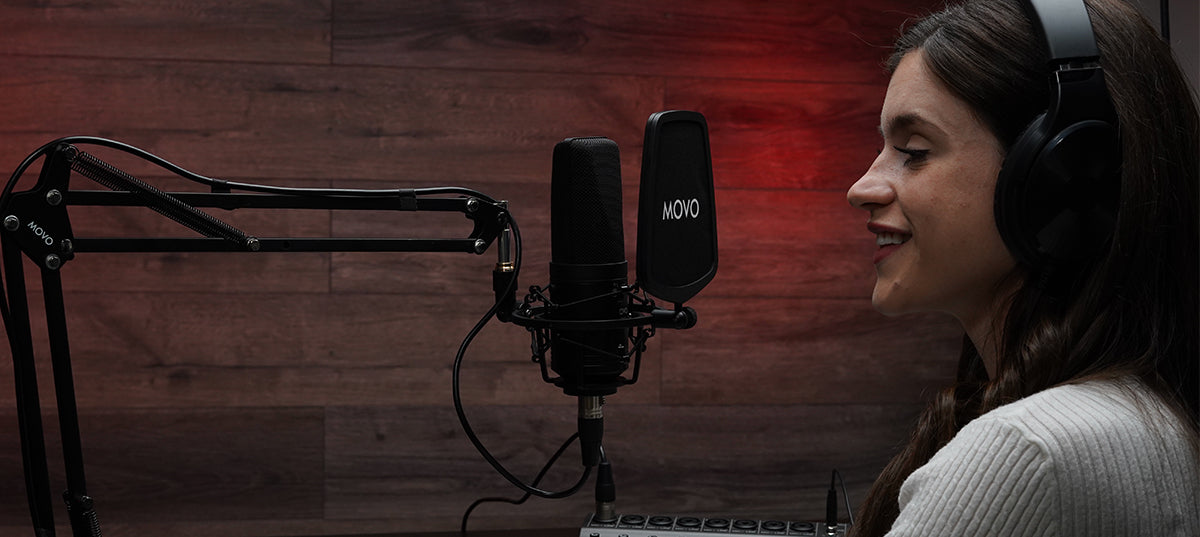Your Cart is Empty
 Free Shipping
Free ShippingEnjoy the convenience of free shipping on all orders. We believe in transparent pricing and delivering value straight to your doorstep. read more...
 30-Day Money-Back Guarantee
30-Day Money-Back GuaranteeShop with confidence knowing you have a full 30 days to try our products. If you're not completely satisfied, return your purchase for a full refund, no questions asked. read more...
 2-Year Warranty
2-Year WarrantyWe stand by the quality of our products with an industry-leading 2-year warranty. Enjoy peace of mind knowing your vlogging and podcasting equipment is covered against defects and issues. read more...
 Lifetime Customer Support
Lifetime Customer SupportOur commitment to you doesn't end at purchase. With lifetime customer support, you can reach out to our expert team anytime for help, advice, or troubleshooting, ensuring you always get the best performance from your gear. read more...

Learn how to improve your sound quality for podcasts in the following blog
by Ed Dutcher May 17, 2021
Podcasting has become one of the fastest growing sectors among digital content creators. This is because of its accessible and relaxing format and relatively low-cost gear requirements. However, one thing that separates a binge-worthy podcast from others is the overall sound quality of the audio recording. Creators of all stripes -- whether they're pros or are searching for audio or video podcast equipment for beginners -- need to keep this in mind when it comes to their podcasts, as there is always room for improvement. To ensure that you have the best possible sound, here are some things you can do about it.
Mind Your Mic
Your podcast microphone can make or break the sound quality of your recording. The less you have to do with post-processing, the better. Whether you’re looking to upgrade or buy your first microphone for podcasting, there are a lot of mid-range options that can be deliver studio-level results, and we especially recommend looking into digital mics. The Movo UM700, for example, is a user-friendly and affordable podcast microphone that provides versatility and superb audio quality.
CLICK HERE to buy UM700 on our store!
CLICK HERE to buy UM700 on Amazon!
Don’t Shy Away From Other Podcast Tools
You can also enhance the audio that your microphone and setup captures by using different podcast tools. While listening back to your recording, plosives might appear louder than other sounds and can disrupt the flow of your audio. These are usually produced by the air you exhale when making “B” and “P” sounds, which can sound like harsh wind noises on the mic. You can use a pop filter like the PF-6 to reduce plosives and optimize your mic’s recording performance.
CLICK HERE to buy PF-6 on our store!
CLICK HERE to buy PF-6 on Amazon!
Straighten Your Back
While there are a number of physical and technological barriers that can affect your overall sound quality, these aren’t the only things you need to worry about. Even if you have the best podcast microphone and equipment at your disposal, your sound quality will still be lacking if you’re not following proper recording procedures.
Make sure you’re in a comfortable but upright position while recording your podcast. so you can speak more naturally and easily without sounding labored or muffled. To aid in your posture, you can use an adjustable mic stand so you can change the position of your mic as needed. If you like to record while seated, a tabletop mic stand like the TMC-3 will be helpful to have.
CLICK HERE to buy TMC-3 on our store!
CLICK HERE to buy TMC-3 on Amazon!
Prep Your Guests Correctly for Remote Recording
While you’re prepared and follow the needed podcasting tips to ensure broadcast-worthy sound, the same can’t always be said for your guests. Though it is ideal that you and your guests can record in the same place, some situations may necessitate remote podcasting recording. Your guests might not have any of their own podcast equipment, which can affect the sound quality if you’re doing a live recording on a video conferencing platform.
To avoid this problem, you can prepare your guests in advance for the podcast by having them record their parts remotely. Make sure they send an AIFF or WAV file of just their voice. In the end, it is much easier to fix the audio on different files and merge them during post. You can even loan a podcast microphone to your guest so they can use it to record. A universal lavalier mic like the LV1-USB can record clear sound and works well with laptops, smartphones, and other devices.
CLICK HERE to buy LV1-USB on our store!
CLICK HERE to buy LV1-USB on Amazon!
For more helpful tips, tutorials, and deals on audio and video equipment, check out our website and our online store on Amazon.
We’re a team of creators and entrepreneurs who proudly support the content creation community through innovative, high-quality products that let you do you. From filmmakers to photographers, vloggers to podcasters, and beyond, Movo helps you share your creative voices across countless mediums and content platforms everywhere.
Receive access to exclusive deals, updates, and more.



